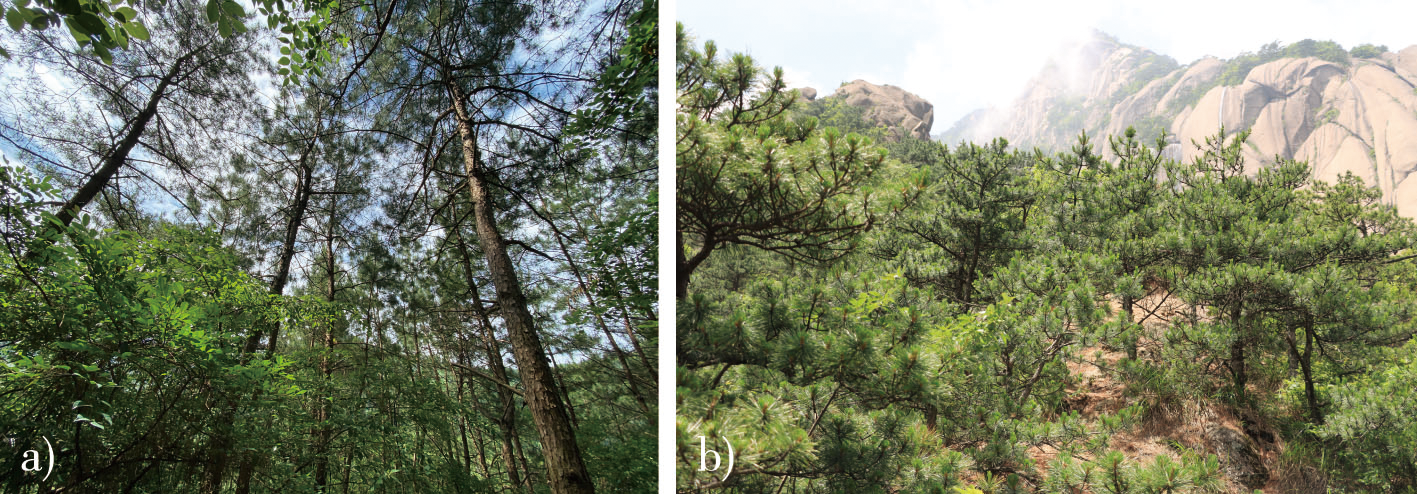 PDF(2167 KB)
PDF(2167 KB)


Community classification, structures and species diversity characteristics of Pinus massoniana and P. hwangshanensis in the eastern China
FAN Mingyang, HU Meng, YNAG Yuan, FANG Yanming
Journal of Nanjing Forestry University (Natural Sciences Edition) ›› 2024, Vol. 48 ›› Issue (1) : 47-58.
 PDF(2167 KB)
PDF(2167 KB)
 PDF(2167 KB)
PDF(2167 KB)
Community classification, structures and species diversity characteristics of Pinus massoniana and P. hwangshanensis in the eastern China
【Objective】 Pinus massoniana is the main coniferous tree species in subtropical China and P. hwangshanensis is the main constructive species in subtropical mid-montane region of the eastern China. Both species coexist at horizontal level but exhibit distinct vertical distributions. The objective of this study is to investigate the distribution patterns of P. massoniana and P. hwangshanensis forests and provide a theoretical basis for the scientific management and conservation of these forest resources. 【Method】 The study was focused on eight typical distribution areas in the eastern subtropical region of China. Non-metric multidimensional scaling analysis (NMDS) and multivariate regression trees (MRT) were employed to explore the differences in community structure and the main influencing factors between the two pine forests. Additionally, a linear mixed-effects model was used to quantify the response of species diversity indices to abiotic factors. Based on the principles for compiling the Vegegraphy of China, a preliminary quantitative classification of P. massoniana and P. hwangshanensis forests was performed. 【Result】 Significant differences were observed in the community structures of P. massoniana and P. hwangshanensis forests, with elevation identified as the primary influencing factor. Mean annual temperature had a significant effect on species richness within both communities, while mean annual precipitation had the most pronounced impact on overall species richness. Elevation exerted a significant influence on the evenness of the two communities. The preliminary vegetation classification resulted in the identification of six associations for P. massoniana forest and five associations for P. hwangshanensis forest. 【Conclusion】 Altitude variations shape the differences in community structure between P. massoniana and P. hwangshanensis forests and directly or indirectly influence species diversity in these communities. The vegetation classification highlights the diversification of vegetation types in the two pine forests and provides a reference for future classification efforts.

Pinus massoniana forest / P. hwangshanensis forest / community structure / species diversity / vegetation classification / the eastern China
| [1] |
王滑, 潘刚, 边巴多吉, 等. 西藏泡核桃群落结构及物种多样性分析[J]. 西部林业科学, 2015, 44(2):43-47,53.
|
| [2] |
柴永福, 岳明. 植物群落构建机制研究进展[J]. 生态学报, 2016, 36(15):4557-4572.
|
| [3] |
马克平, 黄建辉, 于顺利, 等. 北京东灵山地区植物群落多样性的研究:Ⅱ丰富度、均匀度和物种多样性指数[J]. 生态学报, 1995, 15(3):268-277.
|
| [4] |
郑天义, 王丹, 姬柳婷, 等. 太白山自然保护区典型森林群落数量分类、排序及多样性格局[J]. 生态学报, 2020, 40(20):7353-7361.
|
| [5] |
刘欢, 李文君, 陈杰, 等. 陕西米仓山自然保护区6种典型天然林群落的物种多样性[J]. 西北农林科技大学学报(自然科学版), 2017, 45(7):29-39.
|
| [6] |
陈杰, 李文君, 钟娇娇, 等. 陕西米仓山巴山冷杉天然林群落物种多样性及种群分布格局[J]. 西北农林科技大学学报(自然科学版), 2019, 47(1):69-78,89.
|
| [7] |
|
| [8] |
|
| [9] |
|
| [10] |
张克荣, 刘应迪, 朱晓文, 等. 长沙岳麓山马尾松林的群落类型划分及物种多样性分析[J]. 林业科学, 2011, 47(4): 86-94.
|
| [11] |
葛晓改, 肖文发, 曾立雄, 等. 三峡库区马尾松林土壤-凋落物层酶活性对凋落物分解的影响[J]. 生态学报, 2014, 34(9):2228-2237.
|
| [12] |
朱政德. 中国森林的地理分布[J]. 南京林业大学学报(自然科学版), 2004, 28(1):1-8.
|
| [13] |
梁赛花, 邓清华, 丁松, 等. 马尾松林林下植被多样性、生物量研究进展[J]. 南方林业科学, 2015, 43(1):30-31,46.
|
| [14] |
刘艳会, 刘金福, 何中声, 等. 基于戴云山固定样地黄山松群落物种组成与结构研究[J]. 广西植物, 2017, 37(7):881-890.
|
| [15] |
苏松锦, 刘金福, 兰思仁, 等. 黄山松研究综述(1960—2014)及其知识图谱分析[J]. 福建农林大学学报(自然科学版), 2015, 44(5):478-486.
|
| [16] |
|
| [17] |
童再康, 范义荣. 黄山松分布区气候生态区划[J]. 中南林学院学报, 1993(1):81-87.
|
| [18] |
马元屾, 王中生, 余华, 等. 不同海拔梯度下黄山松与马尾松针叶形态·光合生理特性的研究[J]. 安徽农业科学, 2012, 40(29):14155-14158,14173.
|
| [19] |
唐志尧, 方精云. 植物物种多样性的垂直分布格局[J]. 生物多样性, 2004, 12(1):20-28.
|
| [20] |
|
| [21] |
|
| [22] |
|
| [23] |
|
| [24] |
|
| [25] |
吴征镒. 中国植被[M]. 北京: 科学出版社, 1980: 217-230.
|
| [26] |
吴中伦. 安徽黄山黄山松的初步观察[J]. 林业科学, 1963, 8 (2): 114-126.
|
| [27] |
罗世家, 刘永清. 黄山松群丛特征的比较[J]. 湖北民族学院学报(自然科学版), 1999(3): 40-43.
|
| [28] |
林鹏, 叶庆华. 武夷山植被研究(四) 黄岗山针叶林[J]. 武夷科学, 1984(1):23-30.
|
| [29] |
|
| [30] |
余小平, 李新. 重庆南山马尾松群落的数量分类研究[J]. 重庆师范学院学报(自然科学版), 1992(1): 55-60,81.
|
| [31] |
方炜, 彭少麟. 鼎湖山马尾松群落演替过程物种变化之研究[J]. 热带亚热带植物学报, 1995, 3(4):30-37.
|
| [32] |
祁丽霞, 刘金福, 黄嘉航, 等. 戴云山黄山松、马尾松针叶抗氧化酶活性的海拔梯度分布格局[J]. 福建农林大学学报(自然科学版), 2016, 45(1):35-41.
|
| [33] |
罗世家, 邹惠渝, 梁师文. 黄山松与马尾松基因渐渗的研究[J]. 林业科学, 2001, 37(6): 118-122.
|
| [34] |
翟大才, 宣磊, 周琦, 等. 黄山地区马尾松和黄山松基于SSR标记的基因渐渗研究[J]. 分子植物育种, 2018, 16(14):4614-4622.
|
| [35] |
张利锐. 马尾松和黄山松群体遗传学与物种分化研究[D]. 兰州: 兰州大学, 2011.
|
| [36] |
王国宏, 方精云, 郭柯, 等. 《中国植被志》研编内容与规范[J]. 植物生态学报, 2020, 44(2):128-178.
|
| [37] |
方精云, 王襄平, 沈泽昊, 等. 植物群落清查的主要内容、方法和技术规范[J]. 生物多样性, 2009, 17(6):533-548.
|
| [38] |
|
| [39] |
|
| [40] |
|
| [41] |
解雷, 陈浩, 赵荣, 等. 黄山常绿阔叶林群丛数量分类及物种多样性格局——以10.24 hm2森林动态监测样地为例[J]. 陕西师范大学学报(自然科学版), 2023, 51(3):86-95.
|
| [42] |
马克平, 叶万辉, 于顺利, 等. 北京东灵山地区植物群落多样性研究Ⅷ:群落组成随海拔梯度的变化[J]. 生态学报, 1997, 17(6):593-600.
|
| [43] |
|
| [44] |
方文静, 蔡琼, 朱江玲, 等. 华北地区落叶松林的分布、群落结构和物种多样性[J]. 植物生态学报, 2019, 43(9):742-752.
|
| [45] |
吴昊. 秦岭松栎林群落物种丰富度特征及其环境解释[J]. 生态环境学报, 2017, 26(6):931-938.
|
| [46] |
|
| [47] |
|
| [48] |
|
| [49] |
刘开明, 郑智, 龚大洁. 物种丰富度的垂直分布格局及其形成机制[J]. 生态学杂志, 2017, 36(2):541-554.
|
| [50] |
朱德煌. 戴云山黄山松种群特征及其环境因子研究[D]. 福州: 福建农林大学, 2013.
|
| [51] |
李贺, 张维康, 王国宏. 中国云杉林的地理分布与气候因子间的关系[J]. 植物生态学报, 2012, 36(5):372-381.
|
| [52] |
孟苗婧, 张金池, 郭晓平, 等. 海拔变化对黄山松阔叶混交林土壤有机碳组分的影响[J]. 南京林业大学学报(自然科学版), 2018, 42(6):106-112.
|
| [53] |
祁丽霞. 戴云山黄山松-马尾松叶性状对海拔梯度的响应研究[D]. 福州: 福建农林大学, 2015.
|
| [54] |
李淑娴. 马尾松和黄山松物种分化遗传机制研究[D]. 南京: 南京林业大学, 2012.
|
| [55] |
任国学, 刘金福, 徐道炜, 等. 戴云山国家级自然保护区黄山松群落类型与物种多样性分析[J]. 植物资源与环境学报, 2011, 20(3):82-88.
|
| [56] |
刘金福, 朱德煌, 兰思仁, 等. 戴云山黄山松群落与环境的关联[J]. 生态学报, 2013, 33(18):5731-5736.
|
/
| 〈 |
|
〉 |